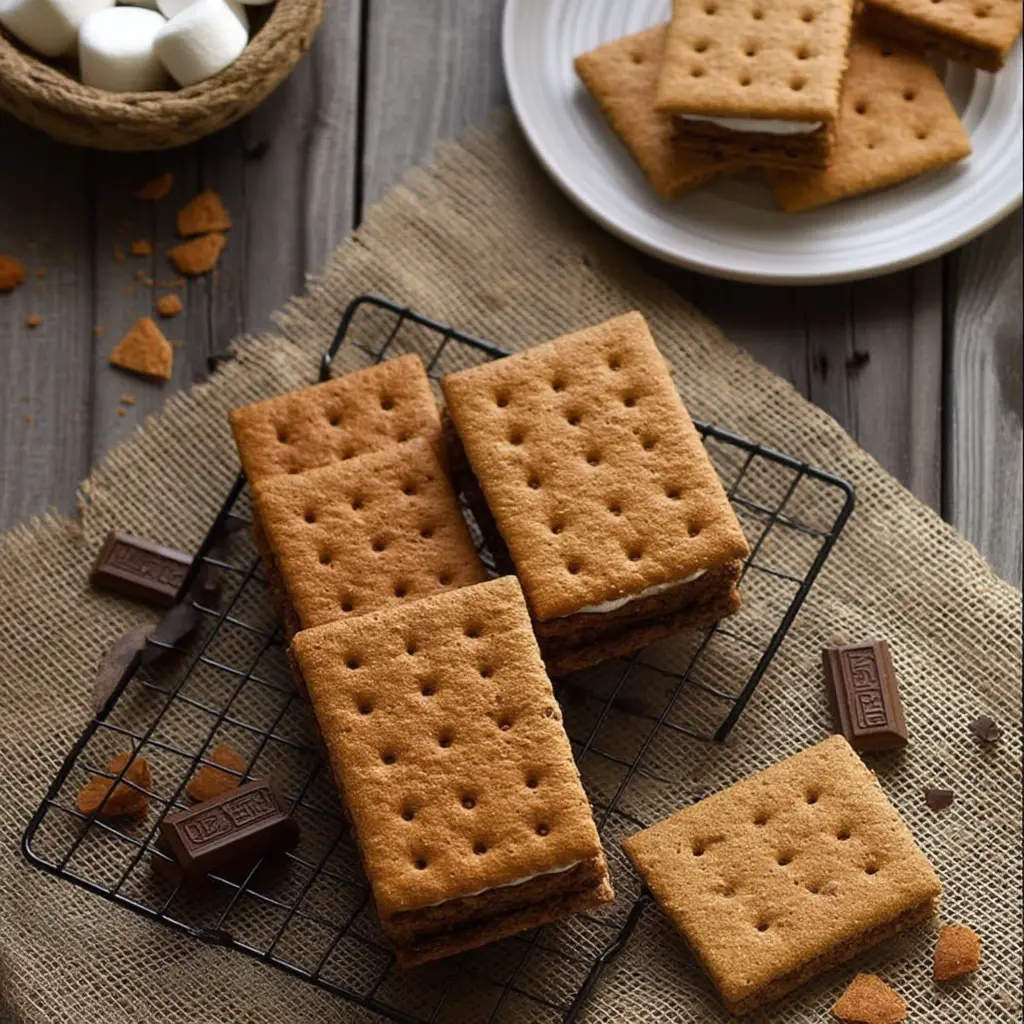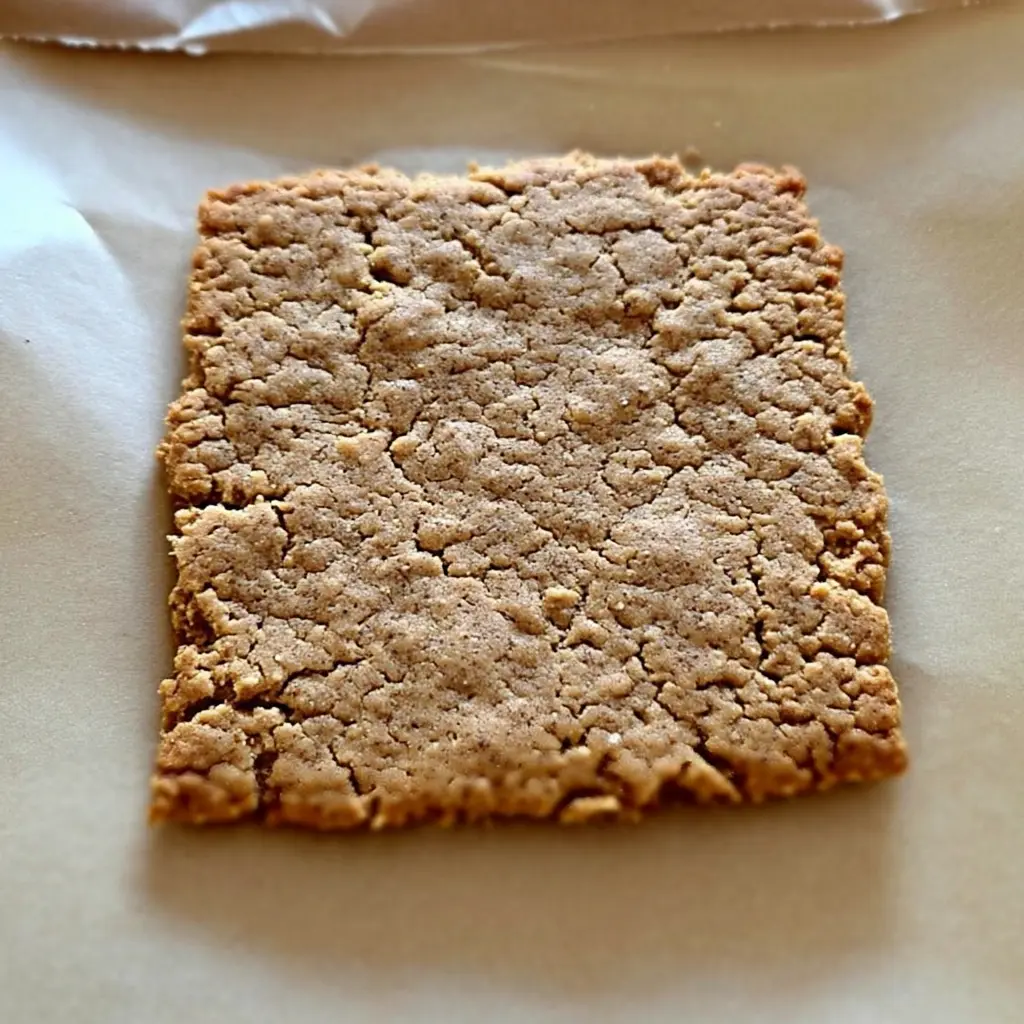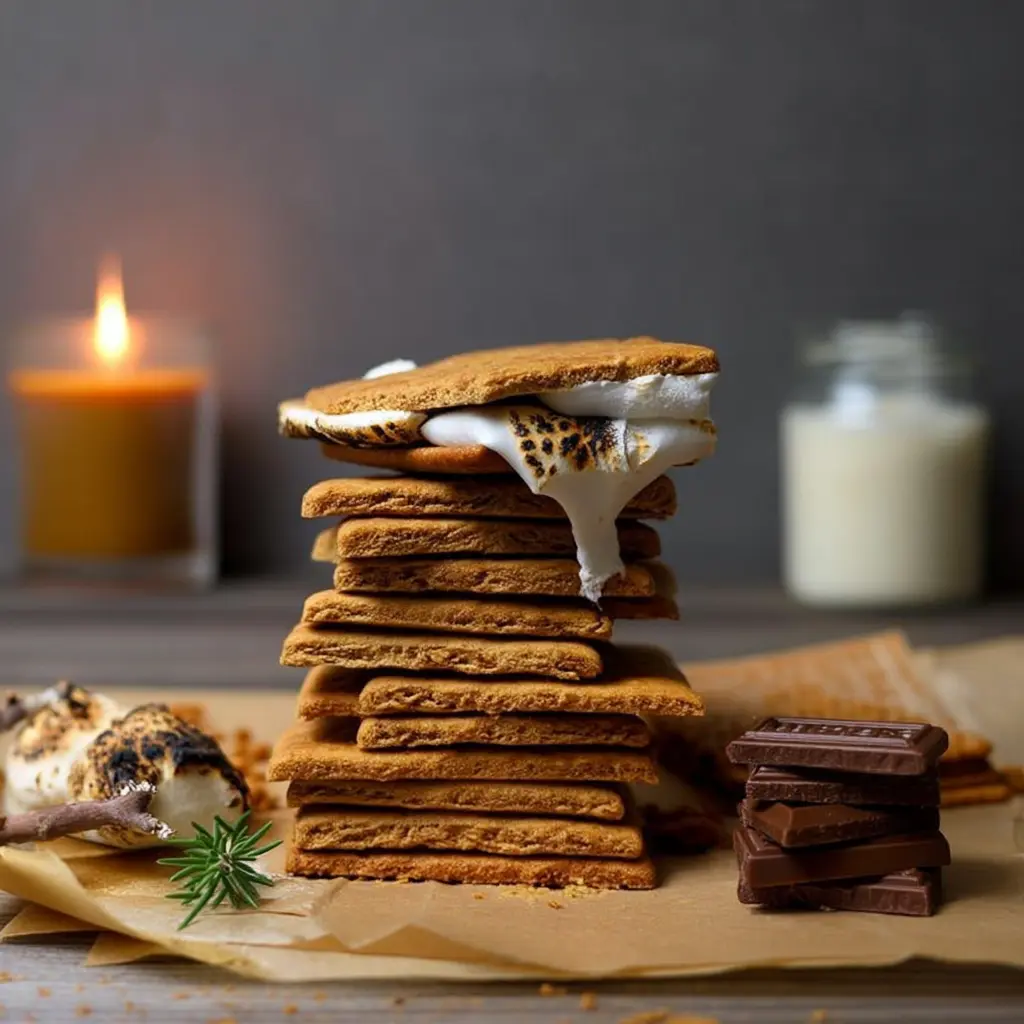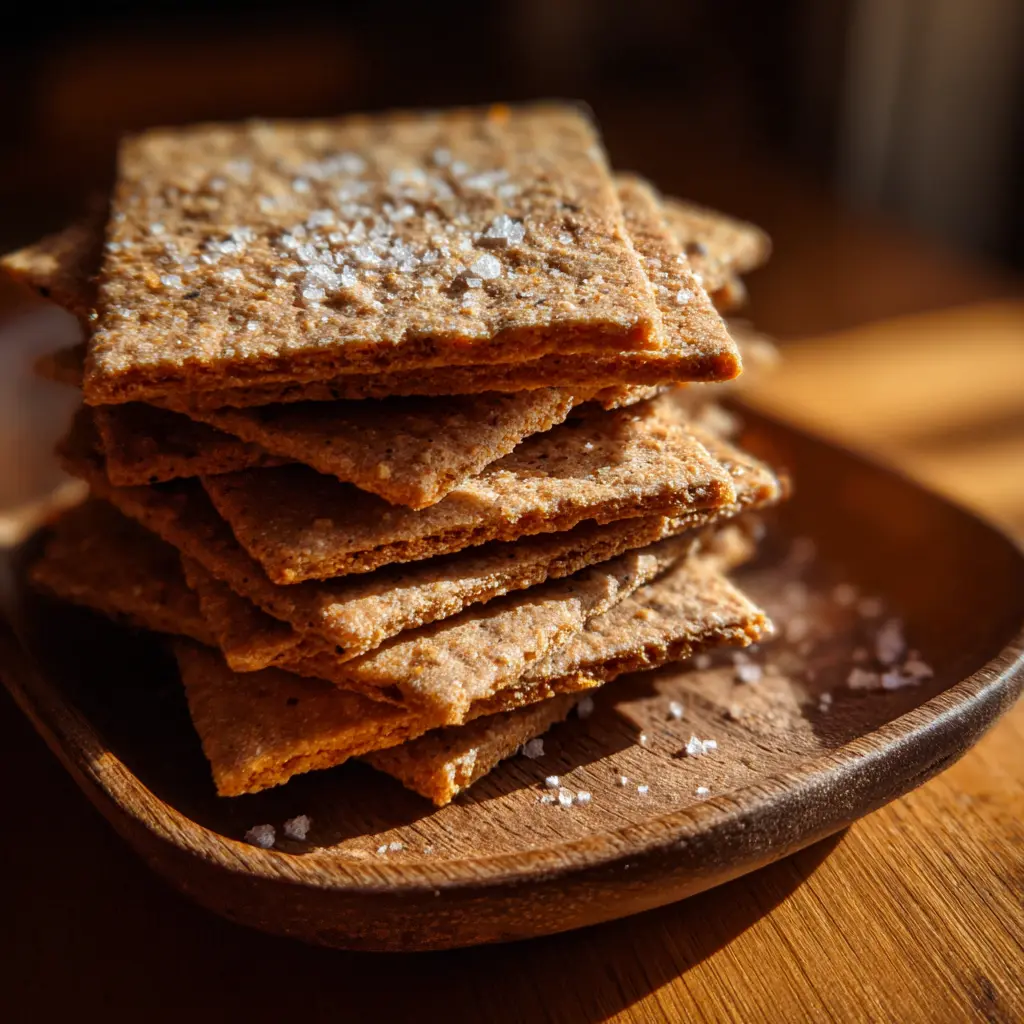Sourdough Graham Crackers are more than just a snack—they’re a story of tradition, sustainability, and flavor, brought to life in your kitchen. At DishRCP, we’re passionate about reimagining classics through the lens of mindful cooking, and this recipe is no exception. Crafted from wholesome graham flour and traditional sourdough fermentation, these crackers blend nostalgic sweetness with rustic charm in every bite.
What inspired us? The challenge of reducing kitchen waste while elevating everyday treats. With a bubbling sourdough starter sitting on the counter, we saw an opportunity: Why toss that flavorful discard when it could be baked into something deeply satisfying? That’s how our Sourdough Graham Crackers came to life—crispy, golden, and just sweet enough, with the kind of real ingredients you can feel good about.
Whether you’re layering them with chocolate and marshmallows or crunching them with a glass of milk, this is a recipe that honors both flavor and function. And if you’re already a fan of fermented bakes, check out our sourdough smores cookies for another creative way to use your discard.
In this guide, we’ll walk you through the step-by-step process of making your own sourdough graham crackers from scratch, explore their nutritional benefits, show you how to customize them, and answer all your burning cracker questions.
Let’s get rolling—literally.

What Are Sourdough Graham Crackers?
History of Graham Crackers and Sourdough Baking
Graham crackers originated in the early 19th century as part of a health movement led by Reverend Sylvester Graham, who believed that a diet of whole-grain foods could help curb sinful appetites. Originally made from unsifted wheat flour, the crackers were dense, slightly sweet, and designed as a healthy alternative to overly refined breads and pastries.
Sourdough, on the other hand, has roots that go back thousands of years. Fermented with naturally occurring wild yeasts and bacteria, sourdough is not just a leavening method—it’s a nutritional upgrade. When combined with graham-style ingredients, it yields a cracker with complex flavor, subtle tang, and improved digestibility.
How Sourdough Changes the Classic Graham Cracker
So what makes sourdough graham crackers unique? Texture, flavor, and gut-friendly fermentation. While traditional graham crackers rely on chemical leaveners and refined flours, our version incorporates a mix of whole wheat and all-purpose flours, real butter, natural sweeteners like honey or Maple syrup and a well-developed sourdough starter or discard.
The starter adds a hint of sourness that balances the sweetness, while the fermentation process helps break down phytic acid, making the nutrients more bioavailable. This gives the crackers a lightly crisp snap with a tender bite and more depth than any store-bought option.
If you’re already dabbling in sourdough, these crackers are a clever and tasty way to repurpose your discard. And if you’re just starting your journey, this might be the easiest entry point into baking with fermented dough.
Fore more tasty recipes follow my pinterest
Table of Contents
Table of Contents
Health Benefits of Sourdough Graham Crackers
Nutritional Comparison with Store-Bought Graham Crackers
Most store-bought graham crackers miss the mark when it comes to nutrition — often made with refined white flour, processed sugars, and artificial additives. In contrast, Sourdough Graham Crackers made at home offer a healthier option using whole ingredients and natural fermentation.
Here’s a side-by-side look at the difference:
| Nutrient (per 20g) | Homemade Sourdough Graham Crackers | Commercial Graham Crackers |
|---|---|---|
| Calories | 55 kcal | 80–100 kcal |
| Total Fat | 2g | 3.5g |
| Sugar | 2g | 5–8g |
| Fiber | 1g | Less than 1g |
| Protein | 1g | Under 1g |
| Preservatives/Additives | None | Often included |
By using a mix of whole wheat and all-purpose flours, natural sweeteners like honey or maple syrup, and active sourdough starter, you’re creating a snack that’s not only lower in Sweet and fatty, yet packed with fiber and full of flavor.
Unlike processed options, these crackers help support your body with slow-digesting carbs, fewer spikes in blood sugar, and better satiety after snacking.
Why Sourdough Is Easier on the Digestive System
Sourdough fermentation does more than boost flavor—it transforms digestion. The live cultures found in sourdough starter begin to break down complex starches and gluten proteins long before you eat them, making them easier for your body to handle.
Here’s how that benefits you:
- Improved digestion: The natural bacteria and yeasts in sourdough pre-digest parts of the dough, easing the work for your gut.
- Reduced gluten load: Fermentation lowers the amount of gluten, which may help those with mild sensitivities (note: not for celiacs).
- More minerals, better absorption: The breakdown of phytic acid helps your body absorb calcium, magnesium, and iron more effectively.
- Lower glycemic response: These crackers won’t cause blood sugar crashes like high-sugar, refined snacks can.
It’s a snack you can feel good about—especially when made with discard that might otherwise be wasted. And it’s not just healthy, it’s also flavorful, with a mild tang that pairs perfectly with a bit of nut butter, cheese, or even dark chocolate.
Print
Sourdough Graham Crackers
- Total Time: 30 minutes
- Yield: 40 crackers
Description
Crunchy, golden-baked homemade sourdough graham crackers crafted with a mix of whole wheat and all-purpose flour. Perfectly crisp with a rich, toasty flavor—amazing on their own and irresistible when turned into gooey, sweet s’mores. Grab your rolling pin—these are the kind of treats you’ll want to make again and again!
Ingredients
- 150 g Whole Wheat Flour
- 120 g All Purpose Flour
- 115 g Butter (super cold – see notes)
- 140 g Sourdough Starter (or sourdough starter discard)
- 3 g Baking Powder
- 3 g Baking Soda
- 3 g Salt
- 30 g Honey
- 50 g Brown Sugar
- ½ teaspoon Cinnamon (optional)
Instructions
Mixing with a Food Processor
Add all the ingredients to your food processor. Pulse until the mixture resembles wet sand. That’s it—quick and easy! This is my go-to method for making sourdough graham crackers.
See notes for extra tips.
Mixing by Hand
Start by grating very cold (preferably frozen) butter.
In a large bowl, combine the whole wheat flour and all-purpose flour.
Add the grated butter and rub it into the flour until the mixture looks like coarse breadcrumbs.
Add the sourdough starter, baking powder, baking soda, salt, cinnamon, honey, and brown sugar. Mix until the dough comes together.
Shaping the Dough
Turn the dough onto a clean surface and press it together until it forms a smooth, cohesive mass.
Divide into two portions, flatten into disks, wrap in parchment paper, and refrigerate.
Chill for at least 2 hours or up to 48 hours to ferment.
When You’re Ready to Bake
Preheat your oven to 160°C (320°F).
Remove the dough from the fridge and roll each disk into a rectangle about ¼ inch thick. Avoid making it too thick—it will take longer to bake.
Cut into rectangles (about 2″ x 2.5″). Use a skewer or fork to poke holes—this prevents puffing.
Baking
Bake on a lined baking sheet for about 30 minutes.
Check for crispness—if not quite done, flip them over and bake a bit longer.
Let them cool on the tray for 5 minutes. Break apart any crackers that didn’t separate, then transfer to a wire rack to cool completely.
Notes
Butter – If you’re using a food processor, no need to grate the butter—just cube it and toss it in. Only grate it if you’re mixing the dough by hand.
Honey – Prefer not to use honey? You can substitute it with maple syrup. Or, if you want to skip the sweetener entirely, just add a splash of milk instead to help bind the dough.
Using a Food Processor – I’ve tested this recipe by pulsing the butter into the flour first, then adding the liquids, and also by tossing everything in at once. Both methods produced nearly identical textures, so go ahead and throw it all in together—it’s a great time-saver, especially for busy moms!
- Prep Time: 5minutes
- Cook Time: 25minutes
- Category: Baking, Side Dish, Sides
- Cuisine: American
Nutrition
- Serving Size: 20g
- Calories: 55kcal
- Sugar: 2g
- Sodium: 96mg
- Fat: 2g
- Saturated Fat: 1g
- Unsaturated Fat: 1g
- Trans Fat: 0.1g
- Carbohydrates: 8g
- Fiber: 1g
- Protein: 1g
- Cholesterol: 6mg
Ingredients Breakdown for Sourdough Graham Crackers
Key Ingredients and Their Functions
Creating delicious Sourdough Graham Crackers starts with a handful of basic ingredients—each one plays a vital role in both taste and texture. Let’s break them down:
- Whole Wheat Flour (150g): This adds depth, a nutty flavor, and a healthy dose of fiber to your Sourdough Graham Crackers. Whole wheat also supports that signature graham texture—slightly coarse, yet tender.
- All-Purpose Flour (120g): Balancing the density of whole wheat, this flour softens the final result, making the crackers easier to roll and crisp up evenly.
- Butter (115g, cold): Cold butter is key. It cuts into the flour and creates flaky layers while giving your Sourdough Graham Crackers a rich, buttery flavor. Frozen and grated for hand mixing, or cubed straight into the food processor.
- Sourdough Starter or Discard (140g): The star ingredient. It provides natural fermentation, a subtle tang, and an opportunity to reduce waste. Using sourdough starter in your Sourdough Graham Crackers deepens flavor while improving digestibility.
- Brown Sugar (50g): Adds a hint of molasses richness and helps the crackers caramelize and crisp up in the oven.
- Honey (30g): Traditional and wholesome, honey gives your Sourdough Graham Crackers that golden finish and a smooth, mellow sweetness. You can also use maple syrup as a substitute or add a splash of milk if you’re leaving it out entirely.
- Cinnamon (½ tsp – optional): It’s optional, but a sprinkle of cinnamon takes the warm, cozy flavor to the next level.
- Salt (3g): Essential for balancing sweetness and boosting every other flavor in the mix.
- Baking Powder & Baking Soda (3g each): Together, these leavening agents create lightness and aid in browning. Even though sourdough is naturally leavened, these help the crackers puff slightly and bake evenly.
Sourdough Starter vs. Discard: What’s Best to Use?
The great thing about this recipe is flexibility. Whether you’re using bubbly active starter or sourdough discard that’s been chilling in your fridge for days, both work beautifully. Here’s how they differ:
| Type | Flavor Impact | Texture Impact | Best For |
|---|---|---|---|
| Active Starter | Slightly milder, fresh tang | Adds a bit more lift and chewiness | Same-day prep |
| Discard | Stronger, sharper sour notes | Slightly denser, but very flavorful | Zero-waste baking |
Discard doesn’t rise much on its own, which is why baking powder and baking soda are included. It’s perfect when you’re cleaning out your jar and need to use that fermented gold in something satisfying—like homemade Sourdough Graham Crackers.
And remember, discard adds complexity, making your crackers more than just sweet—they’re layered with real flavor that only fermentation can bring.
Equipment and Tools You’ll Need
Food Processor vs. Hand Mixing Techniques
When making Sourdough Graham Crackers, the way you mix your dough can make a big difference in both texture and time. You’ve got two main options: a food processor or good old-fashioned hand mixing. Both work well—but the right choice depends on how much time you have and your comfort in the kitchen.
Food Processor Method (Quick & Easy):
If you’re short on time or making a large batch, a food processor is your best friend. Simply toss all your ingredients into the bowl and pulse until the mixture resembles damp sand. That’s it. This method is especially perfect for busy parents or anyone who values convenience.
- Benefits:
- Fast and efficient
- Butter stays cold and evenly distributed
- Easy cleanup
- Pro Tip: Cube your butter before adding it in to make sure it blends smoothly without overmixing.
Hand Mixing Method (More Control, No Equipment Needed):
Want more control or prefer to connect with your food a bit more? Hand mixing is satisfying and straightforward. You’ll grate your frozen butter, then rub it into the flours until the texture resembles coarse breadcrumbs. From there, mix in your starter, sugars, and spices.
- Benefits:
- No special equipment required
- Helps you learn how dough should feel
- Ideal for small batches
- Pro Tip: Use a fork or pastry cutter if your hands warm the butter too quickly.
Both methods lead to delicious Sourdough Graham Crackers, so choose the one that works best for your lifestyle.
Baking Trays, Dough Rollers, and Other Essentials
You don’t need a professional kitchen setup to make bakery-style Sourdough Graham Crackers, but a few simple tools can make your experience smoother.
Must-Have Tools:
- Baking Sheets: Opt for rimless or flat sheets for even heat circulation. Lining with parchment makes cleanup easy.
- Rolling Pin: A standard wooden rolling pin or a French tapered roller will help you flatten your dough evenly to ¼-inch thickness.
- Skewer or Fork: Used to poke the classic holes in your graham crackers. This isn’t just decorative—it prevents puffing.
- Sharp Knife or Pizza Cutter: Use these to slice the dough into perfect rectangles. A clean edge makes for prettier crackers.
- Wire Cooling Rack: After baking, transfer crackers here to cool completely and stay crisp.
Optional But Helpful:
- Bench Scraper: Great for lifting and transferring dough pieces.
- Silicone Baking Mats: Reusable and reduce the need for parchment paper.
Using the right tools doesn’t just improve results—it streamlines the process so that baking Sourdough Graham Crackers becomes a relaxing part of your kitchen routine.

Step-by-Step Sourdough Graham Cracker Recipe
Mixing the Dough: Food Processor & By Hand
Creating Sourdough Graham Crackers begins with a well-mixed dough that balances butter, flour, and your sourdough starter. Here’s how to master both mixing techniques:
Food Processor Method (Preferred for Ease)
- Add All Ingredients at Once
In your food processor, combine whole wheat flour, all-purpose flour, butter (cold and cubed), sourdough starter, baking powder, baking soda, salt, honey, brown sugar, and cinnamon (if using). - Pulse to Combine
Pulse the mixture in short bursts until it looks like moist sand. Don’t overprocess—you want the butter to stay cold for that flakey finish. - Check Texture
Once the dough sticks together when pinched, it’s ready to shape.
Hand Mixing Method (Great for Smaller Batches)
- Grate Frozen Butter
Grate the cold butter using a cheese grater. This ensures even distribution through the flour. - Mix Dry Ingredients
Mix the flours, baking soda, baking powder, salt, and cinnamon together in a large bowl. Stir well. - Rub in the Butter
Use your fingertips to rub the grated butter into the dry ingredients until it resembles breadcrumbs. - Add Wet Ingredients
Add the sourdough starter, honey, and brown sugar, then stir until the mixture is well combined. Knead just enough to form a cohesive dough.
No matter which method you use, your dough should be soft but not sticky—firm enough to hold its shape, but flexible enough to roll.
Forming, Chilling, and Preparing for Baking
Form and Ferment
- Divide & Shape
Split the dough into two portions. Flatten each into a disk and wrap them in parchment paper. - Chill to Ferment
Place the dough disks in the fridge for at least 2 hours—or up to 48 hours. This rest time allows the sourdough to develop its signature tang and improves texture.
Ready to Bake? Let’s Go!
- Preheat Oven
Set your oven to 160°C (320°F). - Roll the Dough
Roll out one dough disk at a time on a lightly floured surface to ¼-inch thick. Don’t go thicker—it’ll slow baking and soften crunch. - Cut into Rectangles
Use a knife or pizza cutter to slice into 2″ x 2.5″ crackers (or your preferred size). - Add Holes
Use a skewer or fork to poke 12 evenly spaced holes. This keeps the crackers flat and classic-looking.
Baking the Crackers
- Bake for 30 Minutes
Place the crackers on a parchment-lined baking sheet and bake them for 30 minutes. Check for crispness. - Flip for Extra Crunch (Optional)
If they’re still soft, flip them over and bake for another 5–10 minutes. Keep a close eye—browning can happen quickly. - Cool on Tray
Let the crackers cool on the baking sheet for 5 minutes. Snap any that didn’t break apart. Then, move them to a wire rack to cool fully and crisp up completely.
Voilà! Your Sourdough Graham Crackers are ready to enjoy—golden, crisp, and layered with sweet, tangy flavor from that glorious fermented starter.
Baking Tips for the Perfect Crunch
Time, Temperature, and Thickness Tips
Achieving that iconic crunch in your Sourdough Graham Crackers isn’t just about baking time—it’s a combo of temperature precision, dough thickness, and technique. Let’s fine-tune your bake:
1. Stick to Low-and-Slow Baking
- Temperature: Always bake at 160°C (320°F)—no higher. This allows the sugars to caramelize gently, locking in that deep, nutty flavor without burning the edges.
- Time: Most batches are crisp at the 30-minute mark, but oven quirks vary. Don’t be afraid to add 5–10 minutes if they’re not fully crisp.
2. Dough Thickness Matters
- Roll your dough to exactly ¼-inch thick. Thicker dough may stay soft in the center, while thinner crackers can burn quickly.
- Use a ruler or rolling pin rings to keep things uniform—it helps every cracker bake evenly.
3. Watch for Color Cues
- Golden brown edges = perfect crunch.
- Pale centers? Give them a flip and a few more minutes.
Pro Tip: Flip your crackers halfway through baking if your oven has hot spots. This evens out heat exposure and boosts crispiness.
Common Mistakes and How to Avoid Them
Even seasoned bakers can hit bumps when working with fermented dough. Let’s troubleshoot common cracker fails:
Mistake #1: Dough Too Wet or Sticky
- Why It Happens: Over-measuring starter, using warm butter, or adding too much honey.
- Try this fix: Rechill the dough and lightly flour it before rolling it out.
Mistake #2: Crackers Didn’t Crisp
- Why It Happens: Dough rolled too thick or not baked long enough.
- Fix It: Flip them over and return to the oven for 5–10 minutes. Cooling them on a wire rack also helps remove residual moisture.
Mistake #3: Crumbly or Dry Texture
- Why It Happens: Not enough butter or over-baking.
- Fix It: Use a digital scale for precision, and don’t exceed the recommended baking time without checking texture.
Mistake #4: No Tangy Flavor
- Why It Happens: Starter wasn’t fermented long enough or too fresh.
- Fix It: Let your dough ferment in the fridge overnight or up to 48 hours for a more pronounced sourdough taste.
Baking perfect Sourdough Graham Crackers takes a little practice, but once you master the golden trio—temperature, time, and thickness—you’ll be turning out flawless batches with ease.
Flavor Variations & Additions
Cinnamon, Chocolate, and Maple Options
One of the best things about making Sourdough Graham Crackers from scratch is the ability to get creative with flavors. Whether you prefer cozy spices, chocolatey richness, or natural sweetness, you can easily tailor this recipe to your taste—while still enjoying the unique tang that only sourdough brings.
Cinnamon Spice
Want a warm, classic graham cracker flavor? Add ½ to 1 teaspoon of ground cinnamon to your dough. It enhances the sweetness and gives your Sourdough Graham Crackers that familiar fall-inspired aroma.
Bonus Tip: Sprinkle cinnamon sugar on top of the crackers right before baking for an added crunch and sparkle.
Chocolate Graham Crackers
Chocolate and sourdough are a match made in heaven. Add 2 tablespoons of unsweetened cocoa powder to the dry ingredients for a rich, chocolatey twist. This turns your homemade Sourdough Graham Crackers into a snack that pairs beautifully with peanut butter, marshmallows, or even espresso.
Pro Tip: Mix in mini chocolate chips for even more indulgence.
Maple or Molasses Sweetness
If you’re out of honey or want a new flavor profile, try:
- Maple syrup (30g): Adds a deep, woodsy sweetness.
- Blackstrap molasses (10–15g): For a stronger, richer taste and added iron content.
Each alternative brings its own dimension, keeping your Sourdough Graham Crackers exciting and far from ordinary.
Making Vegan or Gluten-Free Versions
Baking for specific dietary needs? You can still enjoy the same great crunch and flavor of Sourdough Graham Crackers with a few smart swaps.
Vegan Variation
To make your crackers fully plant-based:
- Replace butter with vegan butter or solid coconut oil (use same weight).
- Swap honey for maple syrup or agave nectar.
- Make sure your sourdough starter is fed using only plant-based ingredients.
The result? Crispy, slightly tangy Vegan Sourdough Graham Crackers with no compromise on texture or flavor.
Gluten-Free Version
Yes, you can make Sourdough Graham Crackers gluten-free—but it takes the right flour blend. Use:
- 1:1 gluten-free baking flour with xanthan gum included.
- Add 1–2 teaspoons of psyllium husk powder to help bind the dough.
Also, ensure your sourdough starter is gluten-free. A brown rice or buckwheat-based starter works well.
Pro Tip: Let gluten-free dough chill longer—up to 24 hours—so it hydrates fully and rolls out more smoothly.
No matter your dietary needs or flavor cravings, these flexible cracker recipes let you take control of what’s in your snacks—without sacrificing the signature bite and bold flavor of true Sourdough Graham Crackers.

Serving Suggestions and Storage Tips
Creative Ways to Serve Sourdough Graham Crackers
Homemade Sourdough Graham Crackers are more than just a wholesome snack—they’re a flavorful base for a variety of sweet and savory creations. Thanks to their crisp texture and rich, naturally fermented taste, they offer a unique twist that elevates everyday snacking.
1. Gourmet S’mores with a Tangy Twist
Layer your Sourdough Graham Crackers with fire-roasted marshmallows and dark chocolate for a next-level take on classic s’mores. The subtle sourdough tang adds complexity and balances the sweetness beautifully.
2. Pair with Dips and Spreads
Use them as dippers for:
- Nut butters like almond, peanut, or cashew
- Whipped ricotta or vanilla yogurt with fresh fruit
- Chocolate ganache or fruit jam for dessert platters
The structure of Sourdough Graham Crackers holds up well to thick spreads, making them a reliable—and tastier—alternative to store-bought crackers.
3. Fast and Nutritious Breakfast Snack
Top your crackers with cream cheese and sliced strawberries or bananas for a quick, no-mess morning bite. The fiber and protein from the ingredients make this an energizing on-the-go option.
4. Crust Alternative for Cheesecakes & Bars
Crushed Sourdough Graham Crackers make an incredible base for no-bake cheesecakes or layered dessert bars. Their tangy-sweet flavor adds depth and character to your crusts, all without relying on highly processed ingredients.
Proper Storage to Maintain Crispness
Because Sourdough Graham Crackers contain no preservatives, storing them correctly is essential to keep that addictive crunch and homemade freshness.
Airtight is Everything
Once cooled completely, place your crackers in a sealed glass jar, metal tin, or plastic container with a tight lid. This locks out moisture and prevents softening.
- Storage Time at Room Temp: 10–14 days
- Best Location: A cool, dry pantry away from heat and sunlight
Freezing for Later Enjoyment
Want to make a big batch ahead of time? Freeze your Sourdough Graham Crackers for easy snacking later.
Here’s how:
- Let the crackers cool fully.
- Stack them with parchment between layers.
- Store in an airtight freezer container.
To serve, thaw at room temperature or re-crisp in the oven at 300°F (150°C) for 5 minutes.
Restore the Crunch if They Go Soft
If humidity sneaks in and softens your crackers, revive them easily:
- Spread them on a baking tray.
- Bake for 5–7 minutes at 300°F (150°C).
- Cool on a rack to dry them completely.
The result? Crackers that snap and crunch like the day you baked them.
Sustainability & Kitchen Efficiency
Why Using Discard in Sourdough Graham Crackers Matters
Every time you feed your sourdough starter, you remove and discard a portion of it—but that so-called “waste” is actually a powerful, flavorful ingredient waiting to be reused. By turning it into Sourdough Graham Crackers, you’re doing more than making a snack—you’re cutting down on food waste, saving money, and enhancing your baking with fermented flavor.
Here’s why sourdough discard is a sustainability hero:
1. Zero-Waste Baking
Using discard in recipes like Sourdough Graham Crackers means you’re maximizing your kitchen efficiency. Instead of throwing away that fermented flour-water mixture, you’re transforming it into something nourishing and delicious.
2. Reduces Food Costs
Why toss a perfectly usable ingredient when you can turn it into snacks that rival store-bought ones? Crackers, cookies, pancakes, and muffins can all be enriched by starter discard, making every ounce of flour stretch further.
3. Eco-Friendly Approach
Homemade Sourdough Graham Crackers help you skip the packaging waste, cut down on grocery runs, and steer clear of preservatives and additives. It’s a small change with big impact—especially when baking becomes a weekly habit.
Batch Baking and Kitchen Time-Saving Tips
Let’s be honest: snacks don’t last long in most households. That’s why batch baking Sourdough Graham Crackers is both efficient and rewarding. Here’s how to make the most of your kitchen time:
1. Double the Recipe
The dough keeps perfectly in the fridge for up to 48 hours. Make a double batch, portion it out, and bake some now and some later—you’ll always have a fresh batch ready when you need it.
2. Freeze Pre-Rolled Dough
Roll out the dough, cut into rectangles, and freeze flat between sheets of parchment. Bake straight from frozen—just add 5 extra minutes to your bake time.
3. Use Leftover Heat
Finished baking a casserole or roasted dinner? Use the leftover oven heat to re-crisp or lightly toast your crackers. It’s an energy-saving trick that keeps your crackers at peak crunch.
4. Create a Sourdough Routine
Bake crackers on discard day, muffins the next, and maybe a loaf of sourdough bread at the end of the week. This system keeps your starter active and your kitchen running smoothly without any waste.
Homemade Sourdough Graham Crackers aren’t just a snack—they’re part of a larger, more thoughtful kitchen culture. They help you minimize waste, use every last spoonful of your starter, and fill your pantry with something satisfying and real.

Conclusion: Why Sourdough Graham Crackers Deserve a Spot in Your Kitchen
From the first crisp bite to the satisfying tang only sourdough can bring, Sourdough Graham Crackers prove that wholesome snacking doesn’t have to be boring—or store-bought. These homemade crackers combine the goodness of whole grain flour, the depth of natural fermentation, and the joy of knowing exactly what’s in your food.
Not only are they better for your health, but they’re also better for your budget and your planet. Using sourdough discard means less food waste, a longer-lasting starter, and homemade snacks that are anything but ordinary. Whether you’re baking for your family, meal prepping for the week, or simply exploring new ways to enjoy sourdough, these crackers deliver every time.
They’re endlessly versatile—enjoy them with sweet toppings, savory dips, or simply straight from the jar. They freeze beautifully, travel well, and can be tweaked to fit any flavor craving or dietary need.
Frequently Asked Questions About Sourdough Graham Crackers
Are sourdough crackers healthy?
Yes, Sourdough Graham Crackers are a healthier alternative to traditional store-bought crackers. They’re made with whole grain flour, natural sweeteners, and sourdough starter, which introduces beneficial fermentation. Unlike processed crackers, they contain fewer additives and preservatives, and the fermentation process makes nutrients more bioavailable. Plus, they’re lower in sugar and fat, making them a better option for everyday snacking.
Is there a healthier version of graham crackers?
Absolutely! Homemade Sourdough Graham Crackers are the healthier version. Instead of refined flour and corn syrup, they use whole wheat flour, real butter, and sourdough discard or starter. You can even swap the honey for maple syrup and adjust the sweetness level. Want to go even further? Try a vegan version using coconut oil and agave for a totally plant-based treat.
Why do you throw away sourdough discards?
Most people throw away sourdough discard because it’s part of maintaining a healthy starter—it prevents over-fermentation and balances the yeast-bacteria ratio. But discard still has flavor and fermentation benefits. Instead of tossing it, repurpose it into delicious recipes like Sourdough Graham Crackers, cookies, muffins, or flatbreads. It’s a smart way to reduce waste and add complexity to your baked goods.
Can you eat 2-year-old graham crackers?
Commercial graham crackers might last a while due to preservatives, but Sourdough Graham Crackers are homemade and preservative-free. For freshness and best taste, they should be eaten within 10–14 days if stored at room temperature or up to 3 months if frozen. Two-year-old crackers? Definitely not safe or tasty. Always check for texture, smell, and visible signs of spoilage before eating any stored food.
